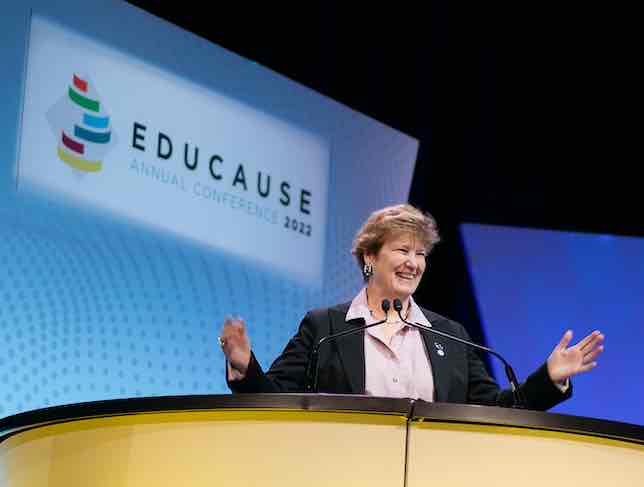Like Leading a World-Class Orchestra: The FLEXspace Community
A Q&A with Lisa Stephens
This year at EDUCAUSE 2022, Lisa A. Stephens accepted the EDUCAUSE Community Leadership Award for her "leadership in exemplary cross-institutional innovation and collaboration." The award recognizes her full career and accomplishments from a wide range of projects, but her leadership in founding and guiding FLEXspace stands out as her flagship project.
Stephens is the assistant dean of online education at the University at Buffalo School of Engineering and Applied Sciences and a senior strategist for academic innovation in the Office of the SUNY Provost. For more than 10 years she has been at the helm of the Flexible Learning Environments eXchange, FLEXspace.org as its executive director and a guiding light for the vibrant FLEXspace community. This global community has grown to over 6,000 members from 1,600 individual campuses and K12 districts in more than 75 countries. Here, CT talks with Stephens about her EDUCAUSE Community Leadership Award for 2022, and about leading the FLEXspace community.

"Leading this community is like being the conductor of a world-class orchestra."
—Lisa Stephens
Mary Grush: Lisa, were you surprised to receive this award?
Lisa Stephens: Absolutely, it's a career highlight for certain! And it's really humbling be nominated for an EDUCAUSE award, because there truly are so many other fine efforts underway that support higher education and do so across multiple campuses.
The EDUCAUSE Community Leadership Award recognizes an effort that benefits everyone by going across campus boundaries, and that's really the basis of FLEXspace. It's key to the way we work.
The EDUCAUSE Community Leadership Award recognizes an effort that benefits everyone by going across campus boundaries, and that's really the basis of FLEXspace.
Grush: So those who participate in FLEXspace are part of a bigger picture, while working on projects that may place an initial focus on their own institutions…
Stephens: Yes, and FLEXspace responds to a need from all facets of higher education concerned with learning environments — to help teams explore the innovations and solutions of respected peers. And I think we're all by nature dedicated to the bigger picture. Isn't that one of the great pleasures of working in higher education? It's being a part of a broader community with a common purpose.
Leading this community for FLEXspace is like being the conductor of a world-class orchestra. Everyone has their instrument and their part to play. But the result comes together like a beautiful symphony… music to my ears, certainly!
One of my nominators told me the dossier highlighted a number of initiatives that I've been involved in, both at the University at Buffalo and more broadly across SUNY. But FLEXspace is really the centerpiece because it's such a far-reaching project.
So, while I was surprised to be receiving the award, I really wanted to accept it on behalf of the entire community including all the people who have helped develop and grow FLEXspace over time.

Lisa Stephens accepts the 2022 EDUCAUSE Community Leadership Award. Photo by Jensen Sutta (jensensutta.com). Courtesy EDUCAUSE, with permission.
Grush: It may be huge, by the numbers of participants and all the data it collects, but FLEXspace seems to take the complexity out of sharing the stories of all these implementations and spaces among the community.
Stephens: Interestingly, Mary, while FLEXspace is huge, it doesn't feel so massive or cumbersome. It kind of feels like people sharing the story of a space, and maybe giving a little bit of advice while encouraging others to share their stories as well by putting them up in FLEXspace. I think people also understand that the resource becomes more valuable with additional content. And more and more records seem to appear almost magically in FLEXspace!
Grush: What will make that apparent magic sustainable? Is that where some technical work is happening in the background?
Stephens: We are in the process right now of upgrading the portal from Drupal 7 to Drupal 9 or 10. We spoke with several developers and learned that it's a pretty heavy lift, but we've identified some people who can help us do that. We'll be working with KWALL, and they have a very good track record with higher education projects. So, we're pretty excited about all that, and we're going to make it even easier for people to participate in FLEXspace — improving the way they upload spaces, search for particular attributes, and connect with each other to share stories of usage and evidence of impact.
We're going to make it even easier for people to participate in FLEXspace — improving the way they upload spaces, search for particular attributes, and connect with each other to share stories of usage and evidence of impact.
It's like my friend and mentor Gerry Hanley, who has led the MERLOT community for many years, often says, "Give a gift, not a burden." We want to be sure to make our tools as easy to use as possible, which will help maintain that community flavor, as you say, by taking away the complexity of sharing all this data and information.
One good example of this is our built-in shared idea board, where small groups can work together privately, using the portal to connect people on their space committee who can look through the lens of their own curricular expertise, to see what kinds of attributes in classrooms would best serve their particular campus.
Related Reading
Earlier this year, CT spoke in-depth with Lisa Stephens about FLEXspace and the FLEXspace Integrated Planning Pathway. Learn more:
Grush: Is that also an example of FLIPP?
Yes! Using the FLEXspace Integrated Planning Pathway (FLIPP) to combine the Learning Space Rating System
(LSRS) with FLEXspace at the campus level — before engaging external consultants — saves time and perhaps money, because you can get your campus advisors aligned along the same principles early in the planning process. FLIPP, along with many of our integrated tools, such as the shared idea board and the toolkit, will facilitate all that in a seemingly simple manner. We invite participants to use our integrated tools, and to share with us how to make them better before the new portal foundation is poured!
We invite participants to use our integrated tools, and to share with us how to make them better before the new portal foundation is poured!
And I'm pretty proud of the fact that FLEXspace has helped more people be invited to the planning table. That alone goes a long way toward preventing some problems. It might be that the A/V people can foresee a problem that an architect may not, and visa versa.
FLEXspace has helped more people be invited to the planning table.
People working in education are so incredibly well intended, and we all work hard. But sometimes the jargon of our expertise can cause us to talk past each other. FLEXspace is a tool to bring people together and help them to see each other's perspectives.
Grush: How long has FLEXspace been bringing the community together? Of course, you were there right from the start…
Stephens: It's been nearly a decade! It really began while I had the privilege of leading a SUNY provost's advisory council on teaching and technology. It was our provost at the time who started the initiative by questioning, with all the money invested in building spaces, whether the right people were around the table. He opened the question of how to share ideas better, about these often costly projects when building or renovating spaces.
Though initially it was a SUNY project, it attracted early interest from hundreds of people throughout higher education who got involved right from the start. Members of SUNY EdToa (the Educational Technology Officers Association) and CCUMC (which recently re-branded as the Education Technology Collaborative, or ETC), were instrumental in helping us figure out how to go about describing spaces in terms that could be easily and consistently shared among different types of professionals and stakeholders. And FLEXspace was born!
Investment from major university partners in addition to SUNY (including the CSU system, Penn State, Foothill De Anza Community College District, and Drexel University), the forming of our advisory board, and valued support from industry-leading corporate sponsors followed as FLEXspace quickly matured. We've especially benefited from our partnership with MERLOT over the years — they have had decades of experience working in open projects and OER. And as always, the FLEXspace community has continued to refine ways to come together to share their spaces for the benefit of all.
The FLEXspace community has continued to refine ways to come together to share their spaces for the benefit of all.
Members will also find us highly accessible through our own content, both on social media and in more traditional formats. We develop workshops, present regularly at conferences, and publish in relevant journals and newsletters, now including a monthly column in the Higher Ed A/V (HEAV) online site.
Grush: With all that you've learned over the years of guiding FLEXspace in mind, can you give us a peek at just a few of the things you're setting your sights on for the future?
Stephens: We've learned valuable lessons about leading large initiatives along the way. There is always a lot of work to be done, but mapping it out into bite-sized chunks, while being cognizant that people are volunteering their (or their institution's) time, is critical to improving FLEXspace for all.
We're considering how to formalize more recognition for those who contribute. It's easy for us to share the credit, because my FLEXspace partner Rebecca Frazee at San Diego State University and I are clear that we don't build the collection; we organize and curate what has been generously contributed to help education improve environments for all different kinds of learners.
Looking ahead further, we're also laying plans to expand the portal to begin to include software tools that complement teaching in built environments, and we're exploring ways to view spaces within immersive environments. So we can only imagine the milestones that will mark the growth and success of the FLEXspace community over the next decade. It's such an exciting time to be involved.